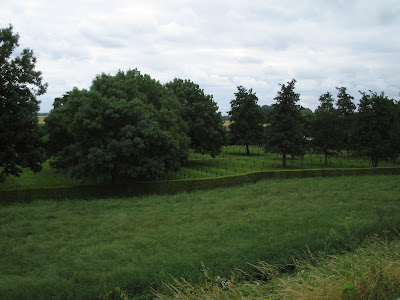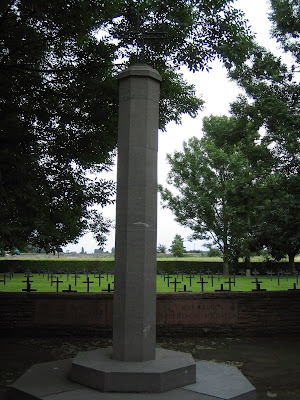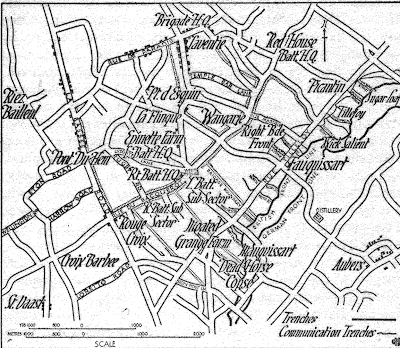Steenwerck German Cemetery



The German military cemetery at Steenwerck was created in April 1918 by the German soldiers during their Spring Offensive. It was then expanded during the retreat of August 1918. Following the war the French Military Authorities brought in a number of German graves from the surrounding neighbourhood. During construction work in 1969 twelve German soldiers from the First World War were discovered and they were re-interred here.
The soldiers buried here are almost all casualties of the German offensive of April 1918 and their defensive battle in August 1918 as the Allies counter attacked. Only 31 of the casualties died in the previous years. The soldiers come from Saxony Silesia, Thuringia, Pomerania, Hesse, Bavaria, Westphalia, Prussia and the Rhineland, Alsace and Lorraine.


This cemetery was begun in June 1917 and used by field ambulances and fighting units until the Germans advanced the following April. Today it has 293 Commonwealth and 37 German burials.
Armentieres and south
Armentieres- War Memorial at Eleven O'clock Square
 It was during the April, 1918 Battle of Lys that the German 4th Army attacked and took the town before General Plumer liberated it on October 2 by which time the Germans had completely destroyed the town.
It was during the April, 1918 Battle of Lys that the German 4th Army attacked and took the town before General Plumer liberated it on October 2 by which time the Germans had completely destroyed the town.
 This square was one of the main routes through the town, and the troops referred to it as "Eleven o’clock square" after the clock tower had been struck by a shell in 1914 and thereafter the hands stuck on eleven o’clock.
This square was one of the main routes through the town, and the troops referred to it as "Eleven o’clock square" after the clock tower had been struck by a shell in 1914 and thereafter the hands stuck on eleven o’clock.
Rue David CWGC
 Cycling five kilometres south-west of Armentieres near Fleurbaix, I came across this cemetery begun by the 2nd Royal Scots Fusiliers in December 1914 and closed to Commonwealth burials in December 1917.
Cycling five kilometres south-west of Armentieres near Fleurbaix, I came across this cemetery begun by the 2nd Royal Scots Fusiliers in December 1914 and closed to Commonwealth burials in December 1917.
Fromelles
Home to 105 graves, many of which are from the Battle of Neuve Chapelle. One burial is that of Captain Charles Edmund Wood, a Harrow and Sandhurst educated soldier who was Adjutant of the 1st Battalion Royal Welsh Fusiliers, killed on the 11th of March 1915. There are special memorials to three men known to be buried in the Cemetery (there are 19 unidentified graves), and one of these, Lance-Corporal F E Carter of the Northamptonshire Yeomanry also died during Neuve Chapelle whose stone reads "A noble son, his Country called, he answered".
 It was during the April, 1918 Battle of Lys that the German 4th Army attacked and took the town before General Plumer liberated it on October 2 by which time the Germans had completely destroyed the town.
It was during the April, 1918 Battle of Lys that the German 4th Army attacked and took the town before General Plumer liberated it on October 2 by which time the Germans had completely destroyed the town. This square was one of the main routes through the town, and the troops referred to it as "Eleven o’clock square" after the clock tower had been struck by a shell in 1914 and thereafter the hands stuck on eleven o’clock.
This square was one of the main routes through the town, and the troops referred to it as "Eleven o’clock square" after the clock tower had been struck by a shell in 1914 and thereafter the hands stuck on eleven o’clock.Rue David CWGC
 Cycling five kilometres south-west of Armentieres near Fleurbaix, I came across this cemetery begun by the 2nd Royal Scots Fusiliers in December 1914 and closed to Commonwealth burials in December 1917.
Cycling five kilometres south-west of Armentieres near Fleurbaix, I came across this cemetery begun by the 2nd Royal Scots Fusiliers in December 1914 and closed to Commonwealth burials in December 1917.Fromelles
Fromelles was in German hands from 1914 until October 1918 when it was liberated by troops from the 5th (Australian) and 61st (South Midland) Divisions. The 5th (Australian) Division was a new formation with no battle experience – it had only recently arrived from Egypt. A handful of its men had fought at Gallipoli, but none on the Western Front. The 61st (South Midland) was a second-line Territorial Force division which had likewise little experience in the trenches, having only been in France for a month.
The front select for the attack was four kilometres long. The German trenches were well made and strongly constructed, as were their wire defences. Concrete bunkers were numerous. Behind Fromelles was a low ridge, the Aubers Ridge. From observation posts on this ridge, the German artillery virtually commanded the battlefield. Preparations for the operation were not disguised, and in the days before the battle Australian and British troops were seen bring up ammunition, supplies, creating a new light railway and carrying up 1,500 gas cylinders. In the end it was decided not to use gas, and the soldiers about to make the attack were ordered to carry them back again. By this time the men were physically exhausted. The Germans, meanwhile, knew an attack was coming and even placed notice-boards on their trenches asking ‘Why so long?’.
But the attack went ahead. At Zero Hour, 6pm on 19th July, twelve battalions from both divisions went over the top. The attack failed, although here and there some troops had made it into the German lines. The British commander of 61st Division did not commit any more troops to the debacle, but the commander of 5th (Australian) Division allowed reserve troops to go forward, only to be unsupported and mowed down in No Man’s Land. By 5am on 20th July the battle was over – those left in the German lines fought on where they could but they were soon overwhelmed. Some 470 Australians were taken prisoner at Fromelles while the 5th (Australian) Division lost over 5,000 men in this battle: by the 20th July there were 2,000 dead in No Man’s Land.
http://battlefields1418.50megs.com/f2guide.htm
There was speculation for many years regarding the existence of an unmarked and forgotten mass grave near Fromelles, containing the remains of Allied soldiers killed during the battle and subsequently buried by the Germans. Research by an Australian historian, Lambis Englezos, identified a site on the outskirts of Fromelles. In 2007, a non-invasive geophysical survey was conducted. The work by British archaeologists was commissioned by the Australian government. The survey gave readings consistent with pits containing the remains of hundreds of soldiers. Additionally, a metal detector survey revealed Australian Army artefacts on the site.
On May 25, 2008, Australian defence personnel minister Warren Snowdon said there was no doubt that bodies of Australian soldiers were buried there. That same day, an archaeological team from the University of Glasgow, contracted by the Australian government, began an exploratory dig at the site. The first conclusive evidence of human remains was discovered on May 29. In total, six burial pits were excavated and human skeletal remains were found in five of them. Only 20% of the area of the pits was exposed, to minimise disturbance of the remains. Numerous artefacts were recovered (e.g. brass military badges and buttons) which confirmed that the bodies in the pits were Australian and British. It was estimated that several hundred allied soldiers "missing in action" had been buried at the site.
Bodies were originally transported there via a German narrow gauge trench railway on July 22, 1916, then tipped into eight pits measuring approximately 10 metres long, 2.2 metres wide and five metres deep. The grave pits were not discovered by various official post-war burial campaigns during the 1920s, which resulted in British Empire war dead being interred in Imperial War Graves Commission cemeteries.
On 31 July 2008 it was announced that all human remains will be exhumed from the mass burial pits and re-buried with full military honours in individual plots at a new war cemetery, situated as close as possible to where the soldiers were found. Exhumation and re-interment will be carried out under the auspices of the Commonwealth War Graves Commission. The original burial location at Pheasant Wood was deemed unsuitable for a permanent cemetery because of the likelihood of regular flooding, and difficult access to the site for visitors. The site for the new permanent CWGC cemetery was selected in autumn 2008 and is located approximately 120 metres from Pheasant wood, where the bodies where found.It will be very similar in appearance to other CWGC war cemeteries in France and will be built to the same standard.
Fauquissart CWGC
Mass grave re-discovered in 2008
There was speculation for many years regarding the existence of an unmarked and forgotten mass grave near Fromelles, containing the remains of Allied soldiers killed during the battle and subsequently buried by the Germans. Research by an Australian historian, Lambis Englezos, identified a site on the outskirts of Fromelles. In 2007, a non-invasive geophysical survey was conducted. The work by British archaeologists was commissioned by the Australian government. The survey gave readings consistent with pits containing the remains of hundreds of soldiers. Additionally, a metal detector survey revealed Australian Army artefacts on the site.
On May 25, 2008, Australian defence personnel minister Warren Snowdon said there was no doubt that bodies of Australian soldiers were buried there. That same day, an archaeological team from the University of Glasgow, contracted by the Australian government, began an exploratory dig at the site. The first conclusive evidence of human remains was discovered on May 29. In total, six burial pits were excavated and human skeletal remains were found in five of them. Only 20% of the area of the pits was exposed, to minimise disturbance of the remains. Numerous artefacts were recovered (e.g. brass military badges and buttons) which confirmed that the bodies in the pits were Australian and British. It was estimated that several hundred allied soldiers "missing in action" had been buried at the site.
Bodies were originally transported there via a German narrow gauge trench railway on July 22, 1916, then tipped into eight pits measuring approximately 10 metres long, 2.2 metres wide and five metres deep. The grave pits were not discovered by various official post-war burial campaigns during the 1920s, which resulted in British Empire war dead being interred in Imperial War Graves Commission cemeteries.
On 31 July 2008 it was announced that all human remains will be exhumed from the mass burial pits and re-buried with full military honours in individual plots at a new war cemetery, situated as close as possible to where the soldiers were found. Exhumation and re-interment will be carried out under the auspices of the Commonwealth War Graves Commission. The original burial location at Pheasant Wood was deemed unsuitable for a permanent cemetery because of the likelihood of regular flooding, and difficult access to the site for visitors. The site for the new permanent CWGC cemetery was selected in autumn 2008 and is located approximately 120 metres from Pheasant wood, where the bodies where found.It will be very similar in appearance to other CWGC war cemeteries in France and will be built to the same standard.
On Saturday 30 January 2010 at 11am, the first of 250 Australian and British soldiers was reinterred at Fromelles (Pheasant Wood) Military Cemetery.
This was the symbolic start of the reburial stage, which will see around 30 reinterments taking place each Monday, Wednesday and Friday in February, weather permitting.
The day was cold, but sunny, and the Australian and British soldiers who formed the bearer party performed their task admirably. Hundreds of local people came to watch the ceremony, along with many visitors from overseas. They were joined by governmental and military dignitaries from the UK, Australia and France.
July 1916: Australian prisoners captured during the Battle of Fromelles being escorted along Route de Béthune in Haubourdin, northern France using Google streetview
July 1916: Australian prisoners captured during the Battle of Fromelles being escorted along Route de Béthune in Haubourdin, northern France using Google streetview
The "Hitler bunker"
About a mile south of Fromelles towards Aubers on the the D141 is this concrete shelter where it is claimed that Hitler spent time whilst serving with the Bavarian Infanterie-Regiment List.
Home to 105 graves, many of which are from the Battle of Neuve Chapelle. One burial is that of Captain Charles Edmund Wood, a Harrow and Sandhurst educated soldier who was Adjutant of the 1st Battalion Royal Welsh Fusiliers, killed on the 11th of March 1915. There are special memorials to three men known to be buried in the Cemetery (there are 19 unidentified graves), and one of these, Lance-Corporal F E Carter of the Northamptonshire Yeomanry also died during Neuve Chapelle whose stone reads "A noble son, his Country called, he answered".


















